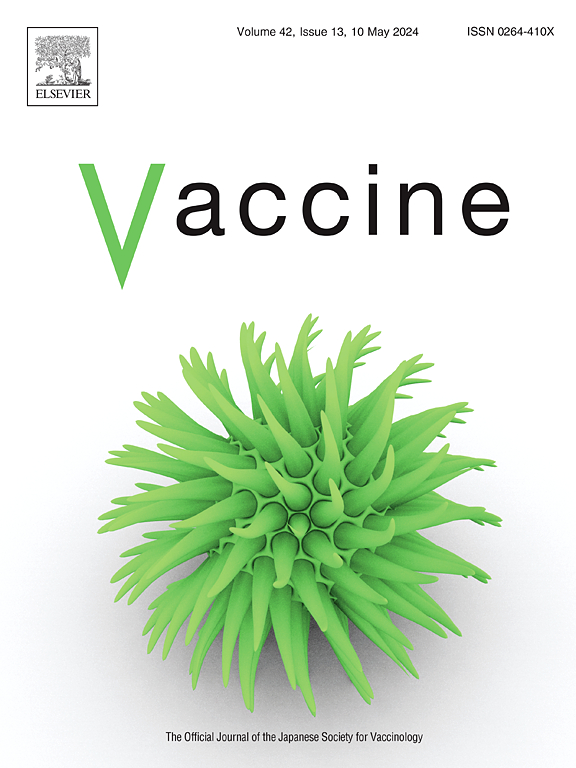Sex differences in parental reasons for lack of intent to initiate HPV vaccination among adolescents ages 13-17 years: National Immunization Survey – Teen 2019-2021
IF 4.5
3区 医学
Q2 IMMUNOLOGY
引用次数: 0
Abstract
Background
This study aimed to evaluate parents' main reasons for lack of intent to vaccinate their adolescent against human papillomavirus (HPV) from 2019 to 2021 and to examine changes in these main reasons stratified by sex of the adolescent.
Methods
NIS-Teen data from 2019 to 2021 were used. Parents who had not vaccinated their adolescent aged 13–17 against HPV and had no intent to do so in the next 12 months were asked the main reason behind this decision. Reasons were grouped into eight domains. A multinomial logistic regression model stratified by sex was used to assess changes in the likelihood of each domain for 2020 and 2021 in comparison to 2019.
Results
A significant interaction between the reasons for lack of intent to vaccinate against HPV and year by sex was documented (p < 0.001). For males, the odds of parents reporting vaccine misinformation (ORadj: 1.30, 95 % CI: 1.26, 1.35), safety and effectiveness concerns (ORadj: 1.08, 95 % CI: 1.05, 1.12), systemic barriers (ORadj: 2.57, 95 % CI: 2.48, 2.66), lack of knowledge (ORadj: 1.44, 95 % CI: 1.39, 1.49), sociocultural barriers (ORadj: 3.20, 95 % CI: 3.09, 3.32), already UTD (ORadj: 2.48, 95 % CI: 2.39, 2.56), and handicapped/special needs/illness (ORadj: 1.88, 95 % CI: 1.79, 1.97), were significantly higher in 2021 compared to 2019. Whereas for females, the odds of reporting all domains were significantly lower in 2021 compared to 2019.
Conclusion
The main domain reported was vaccine misinformation. Parents of males were more likely to report all domains in 2021 compared to 2019, the inverse of females. These can be addressed through public health interventions such as launching media campaigns to combat vaccine misinformation tailored to parents of male adolescents.
13-17岁青少年缺乏启动HPV疫苗接种意愿的父母原因的性别差异:国家免疫调查-青少年2019-2021。
背景:本研究旨在评估2019年至2021年父母不打算为青少年接种人乳头瘤病毒(HPV)疫苗的主要原因,并按青少年性别分层检查这些主要原因的变化。方法:使用2019 - 2021年的NIS-Teen数据。没有给13-17岁的青少年接种HPV疫苗并且在未来12个月内不打算接种疫苗的父母被问及这一决定背后的主要原因。原因被分为八个方面。使用按性别分层的多项逻辑回归模型来评估与2019年相比,2020年和2021年每个领域的可能性变化。结果:缺乏接种HPV疫苗意图的原因与按性别分列的年份之间存在显著的相互作用(p结论:报告的主要领域是疫苗错误信息。与2019年相比,2021年男性的父母更有可能报告所有域名,与女性相反。这些问题可以通过公共卫生干预措施加以解决,例如发起媒体运动,打击针对男性青少年父母的疫苗错误信息。
本文章由计算机程序翻译,如有差异,请以英文原文为准。
求助全文
约1分钟内获得全文
求助全文
来源期刊

Vaccine
医学-免疫学
CiteScore
8.70
自引率
5.50%
发文量
992
审稿时长
131 days
期刊介绍:
Vaccine is unique in publishing the highest quality science across all disciplines relevant to the field of vaccinology - all original article submissions across basic and clinical research, vaccine manufacturing, history, public policy, behavioral science and ethics, social sciences, safety, and many other related areas are welcomed. The submission categories as given in the Guide for Authors indicate where we receive the most papers. Papers outside these major areas are also welcome and authors are encouraged to contact us with specific questions.
 求助内容:
求助内容: 应助结果提醒方式:
应助结果提醒方式:


